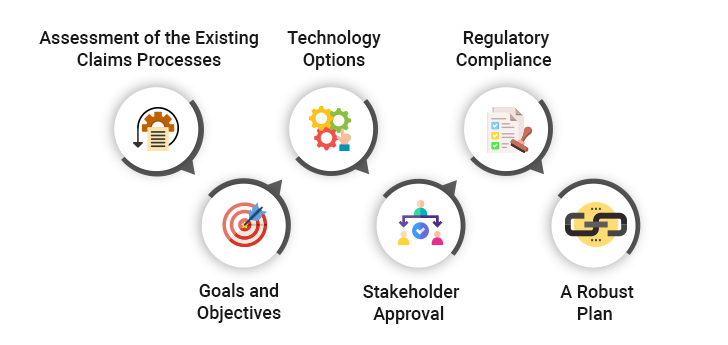Insurance claims transformation sounds promising. After all, it offers a bounty of advantages like improved customer experience, higher efficiency, and fatter profit margins. Each of these benefits puts insurers on the map in different ways. However, it can also be a daunting task—an overly ambitious project that may go awry. Fortunately, a little planning and effective management go a long way toward success.
While you can’t plan for every possible exigency, we have compiled a list of six key considerations to bear in mind before jumping on the digital claims transformation bandwagon.
Steps for Claims Process Transformation
Here is how you can transform your insurance claims process:
1. Assessment of the Existing Claims Processes
Before taking on any transformational journey, the first step is to understand the starting point. It helps you chart your way to the finish line. As such, you need to gain an overview of the existing insurance claims processes. Conduct a thorough analysis of the claims processes to identify the good, the bad, and the ugly. Naturally, the objective of claims transformation is to retain what is working and fix the bottlenecks and pain points. Taking stock of your current situation also helps in developing a logical and priority-based roadmap to address the different problems that you may have encountered during your audit.
2. Goals and Objectives
Overcoming challenges in your existing claims process is one goal of transforming claims management. However, that is not the whole and sole objective. Businesses may have multiple goals and objectives linked to this expedition—some that may even interlink with others. For instance, your broader objective is to make claims processing easier. The natural sub-divisions of this goal would be to make it easier for policyholders to raise claims and for employees to process claims. In doing so, you might also reach the objective of being more customer-centric and operationally efficient. Accordingly, set the required goals and objectives and work on making them quantifiable and practically realizable.
3. Technology Options
Needless to say, the right suite of insurance technologies plays an instrumental role in transforming the insurance claims process. It works as the backbone for all your modernization efforts and benefits policyholders, employees, and the organization as a whole. That being said, there are several InsurTech options in the market. With the buffet of options available, settling down on one or making a choice gets tricky. The best way to approach the selection and decision-making process is by accounting for the tools, technologies, and platforms already in use. Determine ways to expand their scope through integrations. If not, you might consider switching over to a more modular and futuristic solution. Something that overhauls the systems but also centralizes all operations while maintaining agility and scalability.
4. Stakeholder Approval
Whether it is assessing the feasibility of claims processing transformation or implementing change, you require buy-in from stakeholders at every stage. This means that everyone involved and affected by the change, be it executives, agents, team leaders, employees, or customers, should be kept in the know-how of what to expect after the transformation. Simply disseminating this information does not suffice; you also have to capture their feedback and sentiments associated with this move to better align the transformation with the expected outcomes and market demands. Your stakeholders may have a unique take on issues that would otherwise go unnoticed, so involve them in this journey for greater success.
5. Regulatory Compliance
As claims transformation is a significant shift, it is crucial to ensure that your updated processes align with the ever-evolving regulatory landscape. Claims processing often involves sensitive policyholder data, and non-compliance with industry regulations could lead to legal issues and penalties. By embedding compliance checks into your digital claims transformation journey, you ensure that your claims operations are not only efficient but also secure, and legally sound. Incorporate real-time updates for regulatory changes to keep your claims process in line with the latest standards and avoid any roadblocks due to compliance issues.
6. A Robust Plan
Everything leading to this point lays the foundation for a practical and comprehensive insurance claims transformation plan. Now is the time when you put all the data together to devise a strategy detailing specifics like the timeline, budget, implementation strategy, etc. At the same time, you must ensure that the strategy accounts for the latest claims transformation trends. You also have to account for any potential risks, constraints, and roadblocks that may cause you to divert from the plan. Additionally, employing comprehensive claims transformation services significantly improves the effectiveness of your strategy. Draw up an effective change management strategy so that these variables stay within control and have minimal adverse effects on the transformation process.
Modernize the Claims Process to Unlock your Business’ Potential
Latest Trends in Insurance Claims Process Transformation
In addition to accounting for the aforementioned considerations for transforming claims operations, you must also stay apprised of the latest trends surrounding it. After all, they are closely linked to your business goals and decisions. On that note, here are some of the latest trends ruling claims transformation in insurance:
- Cognitive Claims Processing with AI
The insurance sector is advancing toward fully cognitive processing capabilities powered by artificial intelligence (AI). These AI-powered claims systems not only analyze and comprehend extensive datasets but also make complex decisions autonomously. In claims management, this means AI can assess the validity of claims, evaluate damages, and process payments without human intervention, relying on learned behaviors and historical cases. Such cognitive systems continually learn and adapt, enhancing their accuracy and efficiency over time. - Predictive Analytics for Loss Prevention
The future of insurance claims is shifting toward active loss prevention through predictive analytics. Insurers use machine learning models to identify potential risks and intervene before losses occur or escalate. This proactive approach helps lower claim costs and aligns the interests of insurers and customers, as both parties benefit from reduced loss events. - Dynamic Customer Data Interaction
Dynamic customer data interaction layers are revolutionizing claims handling, making the process more responsive, personalized, and efficient. Insurers are increasingly adopting technology that adapts to customer input in real time during the claims process. As new data comes in—from customer inputs, IoT devices, or third-party sources—the claims system dynamically adjusts, enabling more accurate and swift processing. - Multiple-Touchpoint Communication
Dynamic customer interaction layers facilitate multi-touchpoint communication, allowing customers to seamlessly engage with their insurer across multiple channels. This is especially crucial during claims, where the need for consecutive and non-linear communication is high. - System Collaboration
Integrating the customer interaction layer with core insurance systems ensures that all data relevant to a claim is synchronized and accessible across platforms. This seamless integration expedites the claims process by guaranteeing that all necessary information is automatically updated and available to claims handlers, minimizing the time spent on manual data entry and coordination.
Conclusion
Transforming claims management operations can be challenging and complex. However, it is well worth the effort and the pay-off is great. Use the above considerations and market trends as your guide and set yourself up for success. As a result, the cycle from reviewing your current claims process to implementing a new one becomes significantly smoother and more rewarding. So, put in the time to plan and prepare for this change as you welcome a more effective and efficient claims process that delights, rewards, and benefits everyone involved!
Case in Focus
A rapidly growing insurance company offering multi-line insurance was looking to improve its claim processes. In consultation with Damco, the insurer decided to adopt InsuranceNXT, which offered more visibility into the hits and misses of their claims process. Based on these findings the insurer was successful in reducing fraudulent claim detection time by an impressive 95% and improving overall claims processing. Read about this case study on our website.







